Systems of Health and Change: Case Study Analysis and Solutions
VerifiedAdded on 2022/09/28
|5
|950
|22
Case Study
AI Summary
This case study analysis addresses two scenarios related to health systems and change. Case Study A focuses on a newly appointed Deputy Director of Clinical Services in a metropolitan hospital, examining personal goals, enablers, and barriers to change within the organization, and proposing approaches to improve efficiency, patient care, and sustainability of changes. Case Study B explores the establishment of a drug abuse rehabilitation program, identifying enablers, barriers, and strategies for success, including short-term and long-term goals, staffing considerations, and training opportunities. The analysis provides insights into healthcare management, change management, and program implementation, along with references to support the findings.
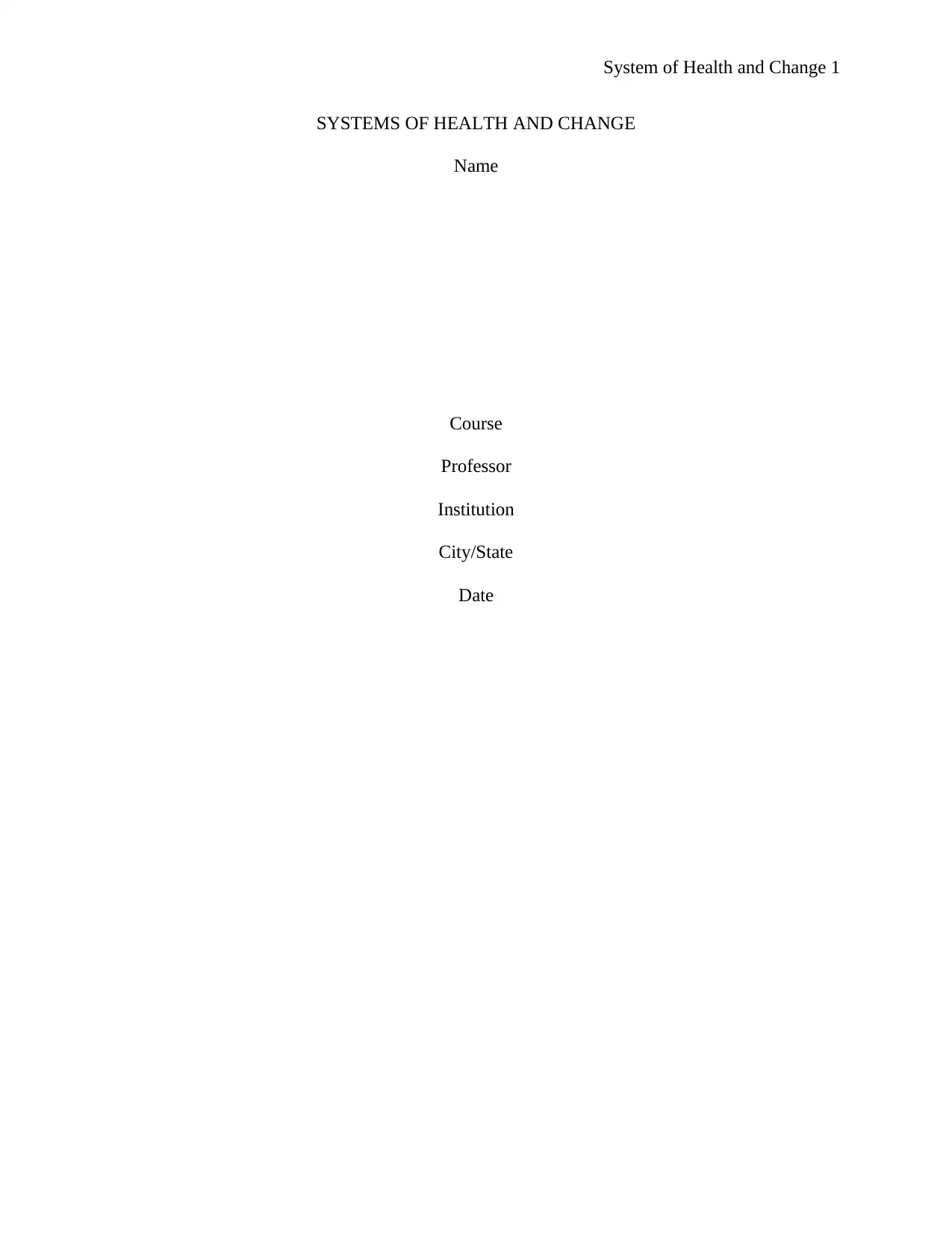
System of Health and Change 1
SYSTEMS OF HEALTH AND CHANGE
Name
Course
Professor
Institution
City/State
Date
SYSTEMS OF HEALTH AND CHANGE
Name
Course
Professor
Institution
City/State
Date
Paraphrase This Document
Need a fresh take? Get an instant paraphrase of this document with our AI Paraphraser
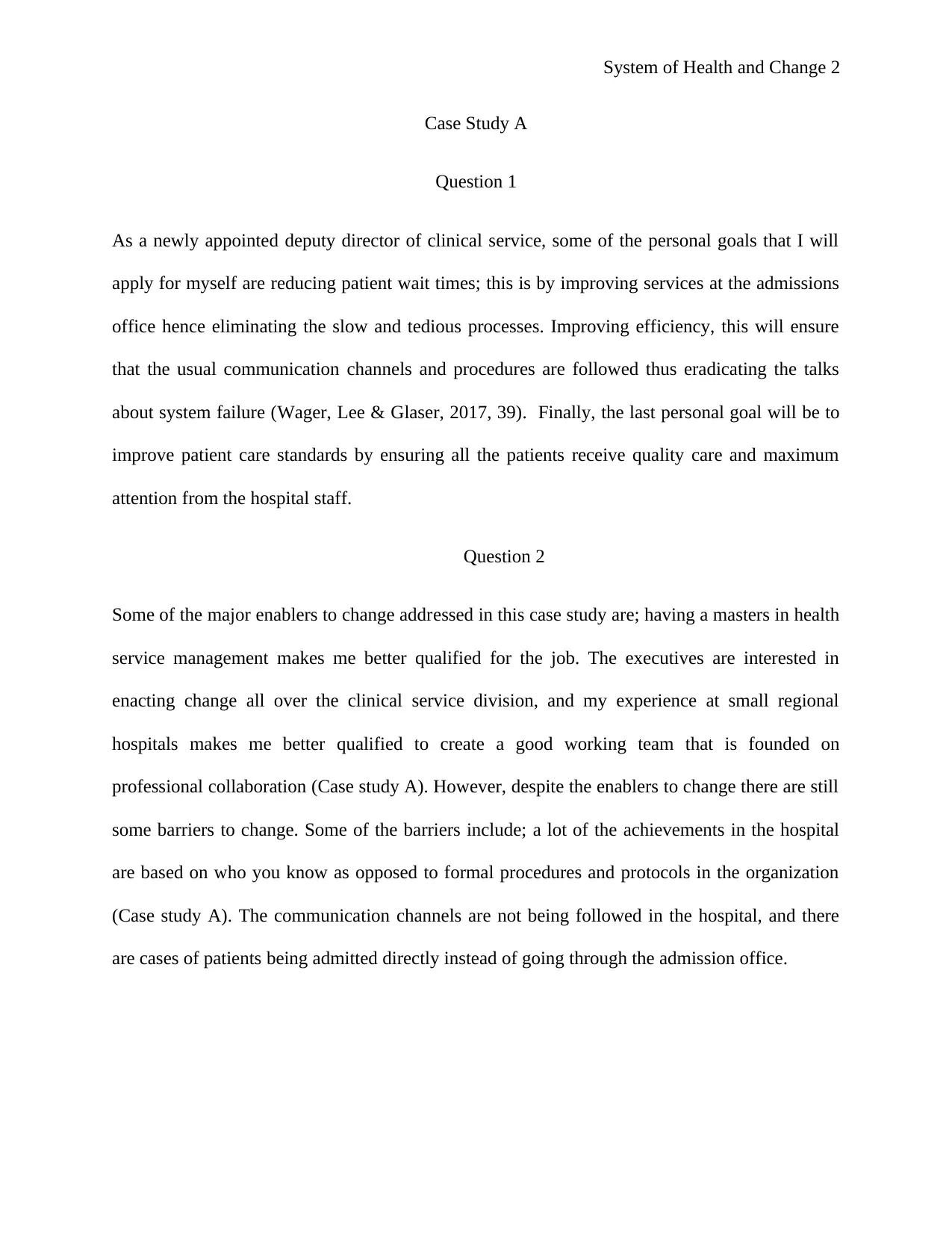
System of Health and Change 2
Case Study A
Question 1
As a newly appointed deputy director of clinical service, some of the personal goals that I will
apply for myself are reducing patient wait times; this is by improving services at the admissions
office hence eliminating the slow and tedious processes. Improving efficiency, this will ensure
that the usual communication channels and procedures are followed thus eradicating the talks
about system failure (Wager, Lee & Glaser, 2017, 39). Finally, the last personal goal will be to
improve patient care standards by ensuring all the patients receive quality care and maximum
attention from the hospital staff.
Question 2
Some of the major enablers to change addressed in this case study are; having a masters in health
service management makes me better qualified for the job. The executives are interested in
enacting change all over the clinical service division, and my experience at small regional
hospitals makes me better qualified to create a good working team that is founded on
professional collaboration (Case study A). However, despite the enablers to change there are still
some barriers to change. Some of the barriers include; a lot of the achievements in the hospital
are based on who you know as opposed to formal procedures and protocols in the organization
(Case study A). The communication channels are not being followed in the hospital, and there
are cases of patients being admitted directly instead of going through the admission office.
Case Study A
Question 1
As a newly appointed deputy director of clinical service, some of the personal goals that I will
apply for myself are reducing patient wait times; this is by improving services at the admissions
office hence eliminating the slow and tedious processes. Improving efficiency, this will ensure
that the usual communication channels and procedures are followed thus eradicating the talks
about system failure (Wager, Lee & Glaser, 2017, 39). Finally, the last personal goal will be to
improve patient care standards by ensuring all the patients receive quality care and maximum
attention from the hospital staff.
Question 2
Some of the major enablers to change addressed in this case study are; having a masters in health
service management makes me better qualified for the job. The executives are interested in
enacting change all over the clinical service division, and my experience at small regional
hospitals makes me better qualified to create a good working team that is founded on
professional collaboration (Case study A). However, despite the enablers to change there are still
some barriers to change. Some of the barriers include; a lot of the achievements in the hospital
are based on who you know as opposed to formal procedures and protocols in the organization
(Case study A). The communication channels are not being followed in the hospital, and there
are cases of patients being admitted directly instead of going through the admission office.
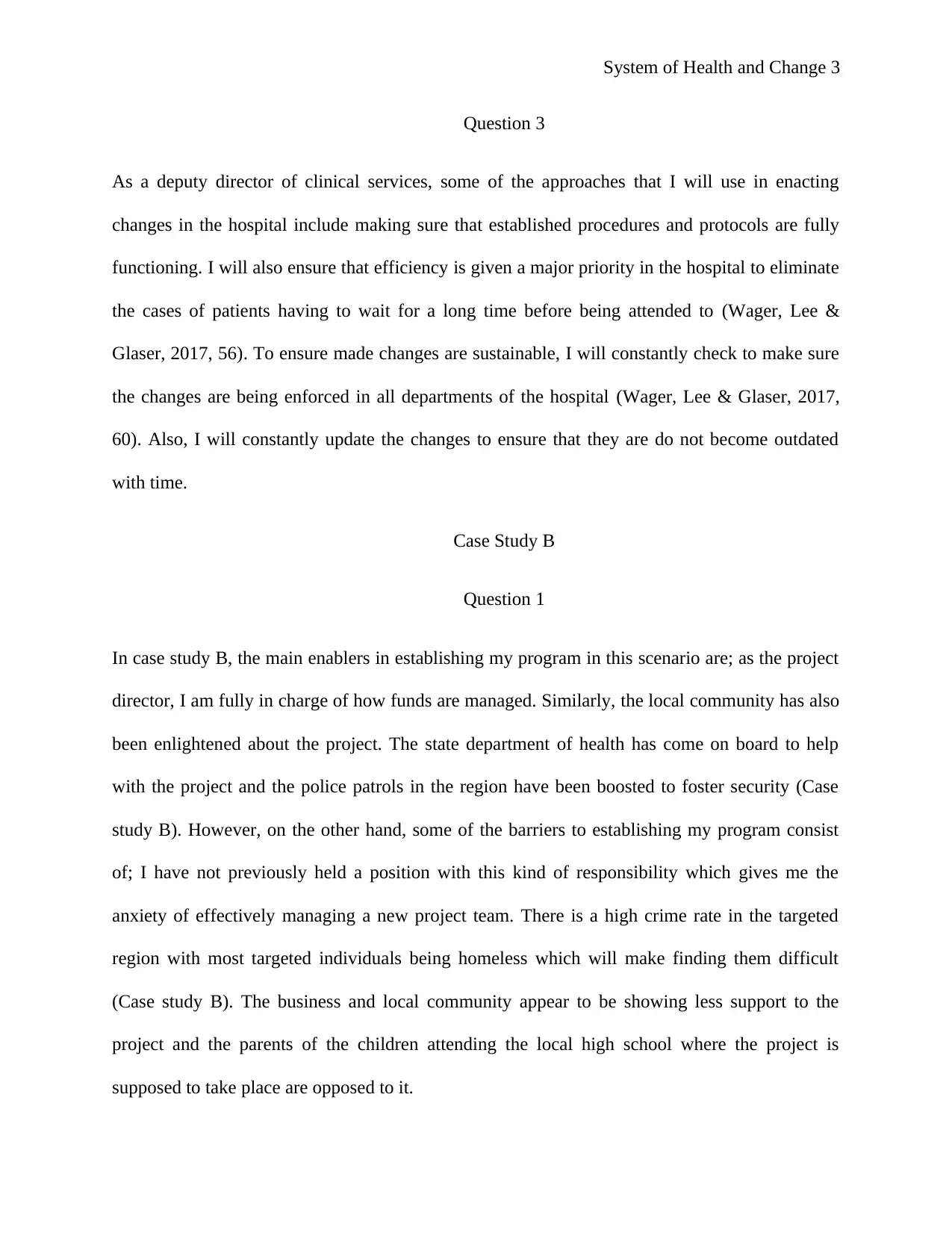
System of Health and Change 3
Question 3
As a deputy director of clinical services, some of the approaches that I will use in enacting
changes in the hospital include making sure that established procedures and protocols are fully
functioning. I will also ensure that efficiency is given a major priority in the hospital to eliminate
the cases of patients having to wait for a long time before being attended to (Wager, Lee &
Glaser, 2017, 56). To ensure made changes are sustainable, I will constantly check to make sure
the changes are being enforced in all departments of the hospital (Wager, Lee & Glaser, 2017,
60). Also, I will constantly update the changes to ensure that they are do not become outdated
with time.
Case Study B
Question 1
In case study B, the main enablers in establishing my program in this scenario are; as the project
director, I am fully in charge of how funds are managed. Similarly, the local community has also
been enlightened about the project. The state department of health has come on board to help
with the project and the police patrols in the region have been boosted to foster security (Case
study B). However, on the other hand, some of the barriers to establishing my program consist
of; I have not previously held a position with this kind of responsibility which gives me the
anxiety of effectively managing a new project team. There is a high crime rate in the targeted
region with most targeted individuals being homeless which will make finding them difficult
(Case study B). The business and local community appear to be showing less support to the
project and the parents of the children attending the local high school where the project is
supposed to take place are opposed to it.
Question 3
As a deputy director of clinical services, some of the approaches that I will use in enacting
changes in the hospital include making sure that established procedures and protocols are fully
functioning. I will also ensure that efficiency is given a major priority in the hospital to eliminate
the cases of patients having to wait for a long time before being attended to (Wager, Lee &
Glaser, 2017, 56). To ensure made changes are sustainable, I will constantly check to make sure
the changes are being enforced in all departments of the hospital (Wager, Lee & Glaser, 2017,
60). Also, I will constantly update the changes to ensure that they are do not become outdated
with time.
Case Study B
Question 1
In case study B, the main enablers in establishing my program in this scenario are; as the project
director, I am fully in charge of how funds are managed. Similarly, the local community has also
been enlightened about the project. The state department of health has come on board to help
with the project and the police patrols in the region have been boosted to foster security (Case
study B). However, on the other hand, some of the barriers to establishing my program consist
of; I have not previously held a position with this kind of responsibility which gives me the
anxiety of effectively managing a new project team. There is a high crime rate in the targeted
region with most targeted individuals being homeless which will make finding them difficult
(Case study B). The business and local community appear to be showing less support to the
project and the parents of the children attending the local high school where the project is
supposed to take place are opposed to it.
⊘ This is a preview!⊘
Do you want full access?
Subscribe today to unlock all pages.

Trusted by 1+ million students worldwide
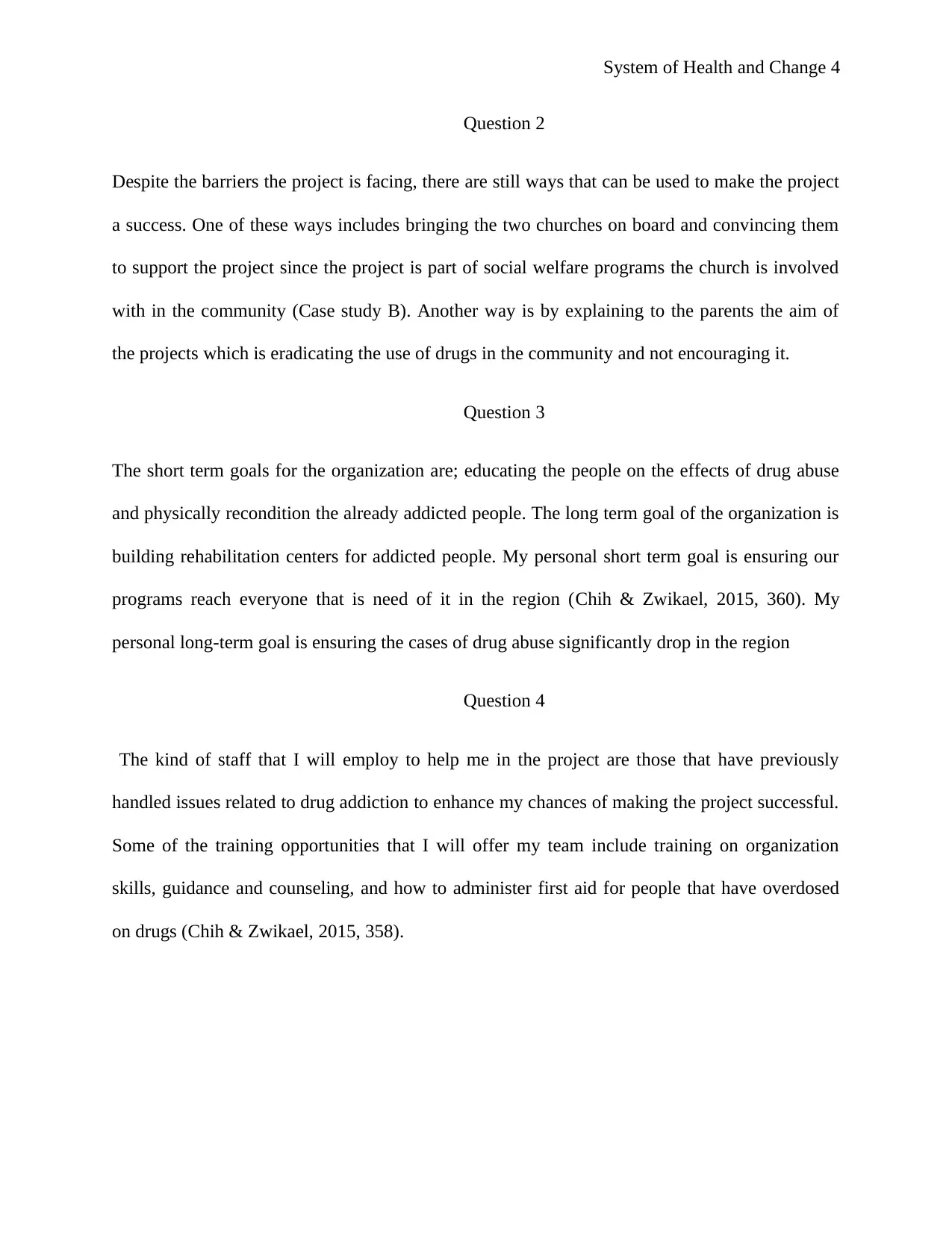
System of Health and Change 4
Question 2
Despite the barriers the project is facing, there are still ways that can be used to make the project
a success. One of these ways includes bringing the two churches on board and convincing them
to support the project since the project is part of social welfare programs the church is involved
with in the community (Case study B). Another way is by explaining to the parents the aim of
the projects which is eradicating the use of drugs in the community and not encouraging it.
Question 3
The short term goals for the organization are; educating the people on the effects of drug abuse
and physically recondition the already addicted people. The long term goal of the organization is
building rehabilitation centers for addicted people. My personal short term goal is ensuring our
programs reach everyone that is need of it in the region (Chih & Zwikael, 2015, 360). My
personal long-term goal is ensuring the cases of drug abuse significantly drop in the region
Question 4
The kind of staff that I will employ to help me in the project are those that have previously
handled issues related to drug addiction to enhance my chances of making the project successful.
Some of the training opportunities that I will offer my team include training on organization
skills, guidance and counseling, and how to administer first aid for people that have overdosed
on drugs (Chih & Zwikael, 2015, 358).
Question 2
Despite the barriers the project is facing, there are still ways that can be used to make the project
a success. One of these ways includes bringing the two churches on board and convincing them
to support the project since the project is part of social welfare programs the church is involved
with in the community (Case study B). Another way is by explaining to the parents the aim of
the projects which is eradicating the use of drugs in the community and not encouraging it.
Question 3
The short term goals for the organization are; educating the people on the effects of drug abuse
and physically recondition the already addicted people. The long term goal of the organization is
building rehabilitation centers for addicted people. My personal short term goal is ensuring our
programs reach everyone that is need of it in the region (Chih & Zwikael, 2015, 360). My
personal long-term goal is ensuring the cases of drug abuse significantly drop in the region
Question 4
The kind of staff that I will employ to help me in the project are those that have previously
handled issues related to drug addiction to enhance my chances of making the project successful.
Some of the training opportunities that I will offer my team include training on organization
skills, guidance and counseling, and how to administer first aid for people that have overdosed
on drugs (Chih & Zwikael, 2015, 358).
Paraphrase This Document
Need a fresh take? Get an instant paraphrase of this document with our AI Paraphraser
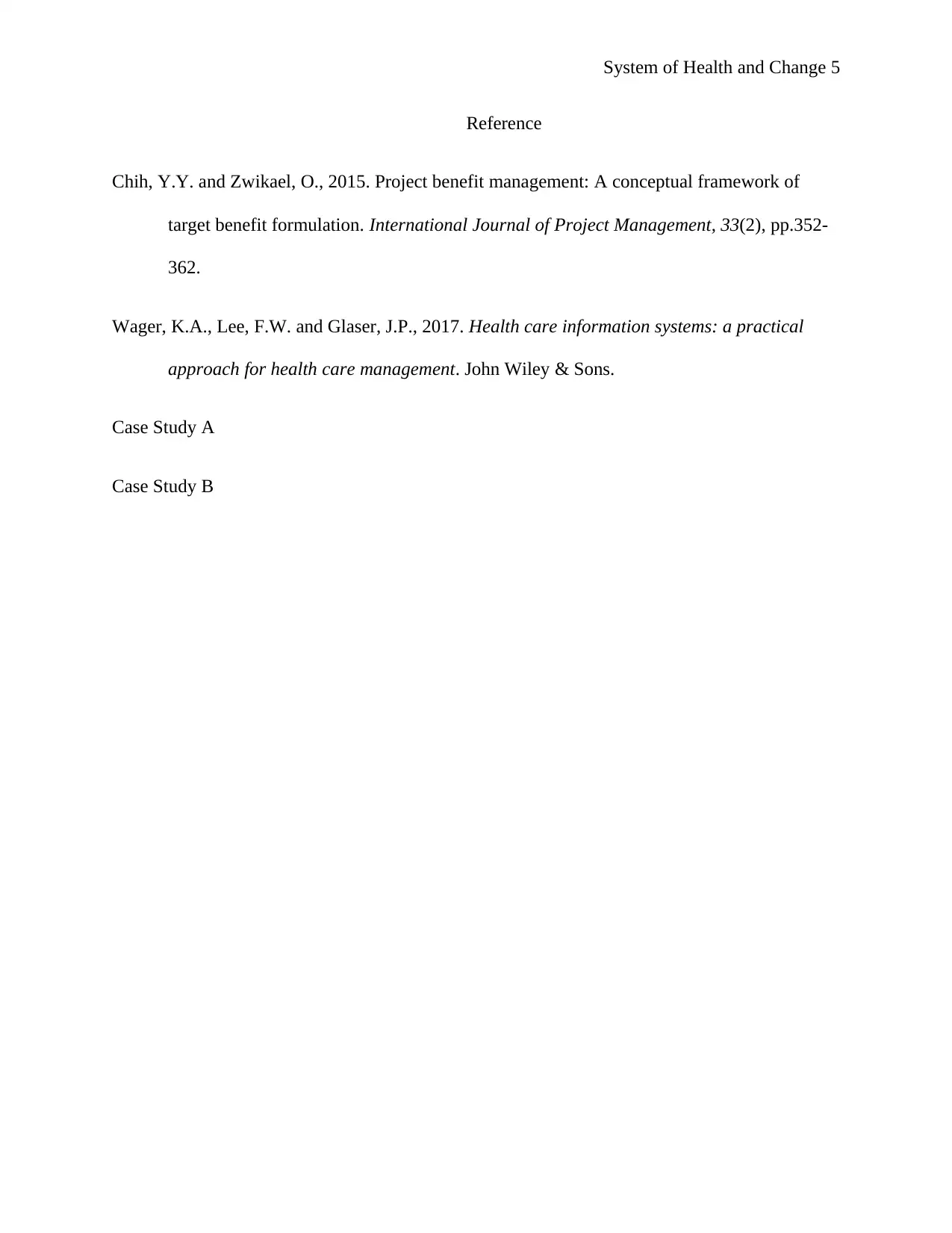
System of Health and Change 5
Reference
Chih, Y.Y. and Zwikael, O., 2015. Project benefit management: A conceptual framework of
target benefit formulation. International Journal of Project Management, 33(2), pp.352-
362.
Wager, K.A., Lee, F.W. and Glaser, J.P., 2017. Health care information systems: a practical
approach for health care management. John Wiley & Sons.
Case Study A
Case Study B
Reference
Chih, Y.Y. and Zwikael, O., 2015. Project benefit management: A conceptual framework of
target benefit formulation. International Journal of Project Management, 33(2), pp.352-
362.
Wager, K.A., Lee, F.W. and Glaser, J.P., 2017. Health care information systems: a practical
approach for health care management. John Wiley & Sons.
Case Study A
Case Study B
1 out of 5
Your All-in-One AI-Powered Toolkit for Academic Success.
+13062052269
info@desklib.com
Available 24*7 on WhatsApp / Email
![[object Object]](/_next/static/media/star-bottom.7253800d.svg)
Unlock your academic potential
Copyright © 2020–2025 A2Z Services. All Rights Reserved. Developed and managed by ZUCOL.


